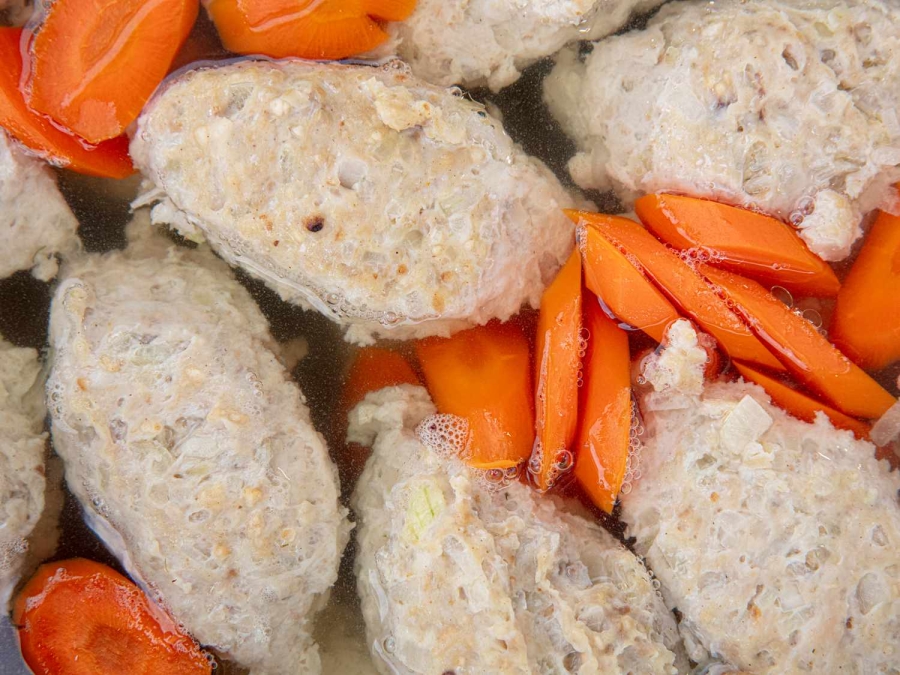Gefilte fish, that humble, grayish loaf served at Shabbat and holiday tables (and the occasional late night snack), may not be the most glamorous dish, but it holds a special place in Jewish history and tradition. If you’ve ever wondered why your grandparents insist on serving it or what makes it so meaningful, you’re about to discover the fascinating story behind this classic Jewish food.
What Is Gefilte Fish?
Let’s start with the basics: Gefilte fish (pronounced geh-FIL-teh) is a dish made from a mixture of ground fish, traditionally freshwater varieties like carp, pike, or whitefish. These are blended with eggs, matzo meal, and seasonings, then shaped into balls or loaves. The dish is usually poached and served cold, often with a dollop of horseradish (chrein).
While it might seem simple, gefilte fish is anything but boring. Its history is rich, spanning centuries and continents, and it represents far more than just a food item.
The Historical Roots
The word “gefilte” comes from the Yiddish word for “stuffed,” as the dish was originally made by stuffing fish skin with a ground fish mixture. This technique became popular in Jewish communities across Eastern Europe, where fish was a staple food.
Why fish? Two reasons:
- Kosher Laws: Jewish dietary laws (kashrut) prohibit mixing meat and dairy at the same meal, but fish is considered neutral (pareve), making it a versatile and easy choice for Shabbat and holidays.
- Practicality: Fish was often cheaper and easier to prepare than meat, especially for poor Jewish communities in Eastern Europe. Grinding the fish and mixing it with fillers like breadcrumbs or matzo meal allowed families to stretch their ingredients further, feeding more people with less.
Shabbat Connections
Gefilte fish became a Shabbat staple because it solved a halachic (Jewish law) problem. According to Jewish law, Jews are not permitted to perform specific labors on Shabbat, including tasks like removing bones from fish. By pre-preparing the fish and grinding it, families could serve a delicious, bone-free dish without breaking Shabbat laws.
Cultural Significance
Gefilte fish is more than a recipe; it’s a symbol of Jewish resilience and adaptability. As Jewish communities moved across the globe, they brought gefilte fish with them, adapting the recipe to local ingredients. In Poland, the dish was often sweetened with sugar, while in Lithuania, it was more savory. In America, jarred gefilte fish became a popular convenience for busy families.
The dish also tells the story of Jewish survival. In times of poverty and persecution, gefilte fish represented a creative way to preserve traditions and celebrate Shabbat and holidays despite hardship.
A Taste of Memory
For many Jewish teens today, gefilte fish might seem outdated or unappetizing. But for older generations, it’s a taste of home and history. Sharing gefilte fish at family meals connects us to the generations who came before us, reminding us of their struggles, perseverance, and dedication to keeping Jewish traditions alive.
Gefilte Fish in Modern Times
Today, gefilte fish has undergone a bit of a renaissance. Chefs and food bloggers are reinventing the classic recipe with fresh herbs, spices, and even modern plating techniques. Whether you enjoy it straight from the jar or as a gourmet dish, gefilte fish is a reminder of how Jewish food evolves while staying rooted in tradition.
Why It Matters
So, why should you care about gefilte fish? Because it’s not just about the food; it’s about what it represents. Gefilte fish is a link to our ancestors, a symbol of our history, and a delicious (or at least interesting!) way to connect with Jewish culture.
Next time you see it on the table, take a bite and think about the generations of Jews who prepared, ate, and cherished this dish. Gefilte fish isn’t just food—it’s a story, and now you’re a part of it.





Add a Comment